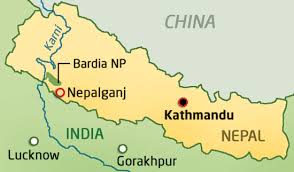Having some time on our hands, a few friends and I took a trip to the southwest corner of the country and made our way slowly to Bardia National Park where we wandered through the wilderness looking for and then escaping from large wild animals. Much of the terrain looked like the land does in the two following images.
 |
| The view from the top of a lookout tower. |
 |
| We posted up at this spot for a few hours and scanned for birds and other wildlife. I took a nap. |
 |
| Bardia National Park (NP) is located northwest of Nepalganj (image source). |
Nepal is made up of three very different geographic regions: 1) Terai, 2) Hill, and 3) Mountain. Kathmandu is located in the hilly region. In the south bordering India is the Terai region (see the map). Being further south and about 4000 feet lower in elevation than Kathmandu, the cities in the Terai are dry, dusty, and unpleasantly warm. This area is culturally influenced by India and shares the same climate as the massive Indian Plains. In addition, the land is flat so large-scale rice paddy farming that is prohibited by the hills and mountains further north is possible here.
 |
| The three main geographic regions or belts of Nepal: Terai, Hills, and Mountains (image source) |
 |
| A satellite image highlighting Nepal's diverse geography (image source). |
 |
| Another way to look at the elevation change across Nepal (from south to north) (image source). |
 |
| Our fantastic guide. |
 |
| A wild elephant. |
The Tharu people are the dominant ethnicity around Bardia and in much of the Terai. They have an interesting mix of Nepali and Indian blood and and are said to be direct descendants of Lord Buddha. Life looks a bit different for people in the Terai with mud walled homes and lots of forestry products.
 |
| A row of Tharu houses. |
 |
| People bike everywhere on Indian made bikes. |
 |
| Whole days are committed to cutting through these trees in order to make door and window frames. |
 |
Some more woodworking.
|
On our second day in Bardia we found out there was a bandha (or strike) and we would be unable to leave. People who participate in the strikes are known to drink heavily and there are numerous stories of vehicles being torched for breaking the rules of the strike. After getting confirmation from a few other sources we found out that indeed there would be a bandha of unknown length. These strikes can last a day or can be extended up to two weeks. This particular bandha was organized and implemented by political parties in the region wanting more autonomy from the federal government. Bardia was nice but we didn't want to spend two weeks there. Our options were to wait it out (for however long or short the strike would last) or to ride bicycles the few hundred kilometers to the nearest operating bus stop. We went so far as to visit some bike shops but lucked out with the strike only lasting two days.
 |
| A very old birth control billboard along the road near Bardia. |
 |
| Weed grows wild in the fields. Travelers are advised to wash boots before heading back to the airports. |
 |
| We spent a great afternoon during the bandha (the stirke) at the local swimming hole. |














No comments:
Post a Comment